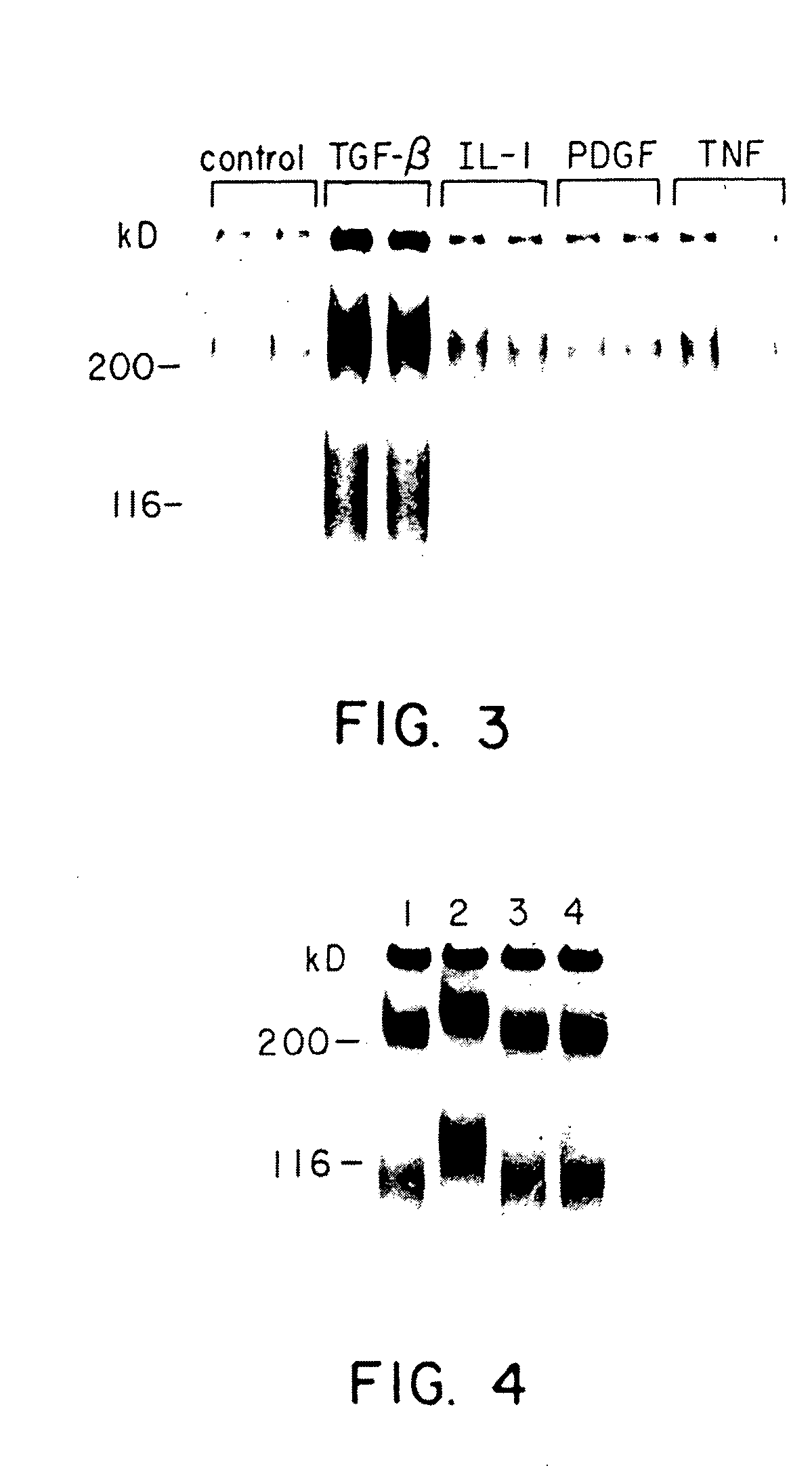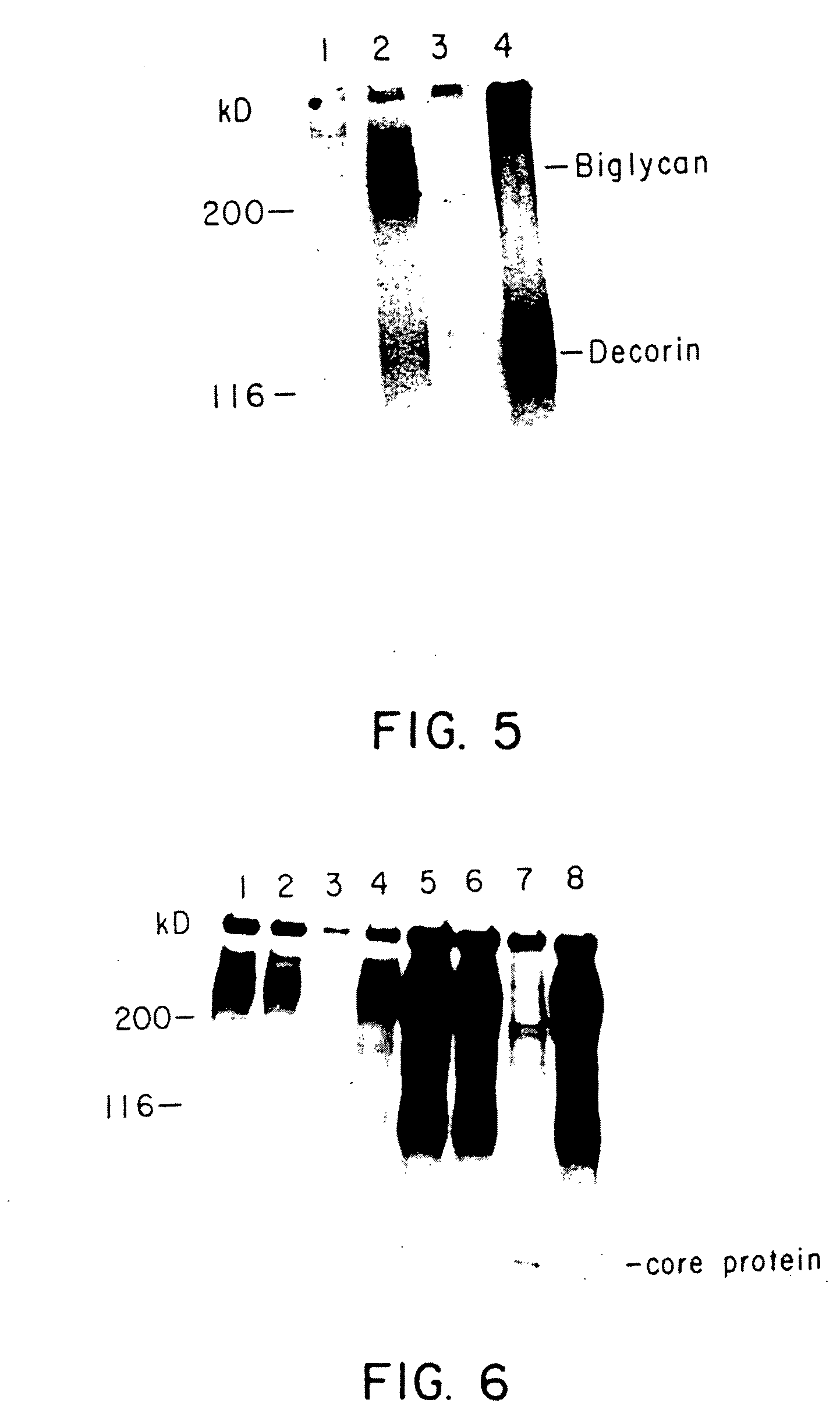Inhibiting transforming growth factor beta to prevent accumulation of extracellular matrix
a technology of transforming growth factor and beta, which is applied in the direction of antibody medical ingredients, peptide/protein ingredients, peptide sources, etc., can solve the problems that none of these factors has been shown to directly influence the synthesis or degradation of extracellular matrix components, and their influence on the pathological accumulation of matrix components has been unclear
- Summary
- Abstract
- Description
- Claims
- Application Information
AI Technical Summary
Benefits of technology
Problems solved by technology
Method used
Image
Examples
example ii
Identification of Proteoglycan Species
[0039] 1. Immunoprecipitation
[0040] Immunoprecipitations were performed by adding b 100 .mu.l of antiserum to 500 .mu.l of conditioned medium or 300 .mu.l of cell extract collected from duplicate wells in the presence or absence of added growth factors. In duplicate wells, cells were detached and counted to ensure uniformity of cell number. Preimmune serum was used in parallel control experiments. The samples were incubated overnight at 4.degree. C. with mixing in 4 ml conical tubes precoated with bovine serum albumin (BSA). Protein-A-Sepharose beads (Sigma, St. Louis, Mo.) were preincubated with fresh RPMI for 60 minutes at 22.degree. C. To precipitate the antigen-antibody complexes, 50 .mu.l of suspended protein-A-Sepharose was added to the samples, and mixed at 4.degree. C. for 120 minutes. The samples were centrifuged for 10 minutes at 2000.times.G and the supernatant removed. The pellets were washed 10 times with 1 ml of ice cold PBS contai...
example iii
Induction of Experimental Glomerulonephritis, Histologic Examination, Preparation of Glomerular Cultures, Culture media and Antibody Production
[0045] a. Induction of Experimental Glomerulonephritis
[0046] To study the role of TGF-.beta. in the glomerular proteoglycan synthesis in vivo, a glomerulonephritis model in which the disease is induced with an anti-thymocyte serum (ATS) was produced by immunizing New Zealand white rabbits with 1.times.10.sup.6 rat thymocytes in complete Freund's adjuvant, followed by boosting with 1.times.10.sup.6 thymocytes given intravenously two and four weeks later. Preimmunization serum was collected from the same animal and used in control experiments as normal rabbit serum. Prior to use, ATS and normal serum were absorbed 3 times each with packed rat erythrocytes and rat liver power. The serum was then heat inactivated at 56.degree. C. for 30 minutes. Glomerulonephritis was induced in Sprague Dawley rats (4-6 weeks old) by intravenous administration of...
example iv
Glomerular Proteoglycan Production And TGF-.beta.
[0057] Groups of nephritic animals were sacrificed 1, 4, 7, 14 and 28 days after being injected with ATS. Their glomeruli were isolated, placed in culture, and biosynthetically labeled to identify newly synthesized proteoglycans. One day after ATS injection, proteoglycan synthesis was the same as in normal controls; however, on day 4 there was a striking induction of proteoglycan production, that reached a 49-fold increase on day 7, and which then declined on days 14 and 28 (FIG. 9). To determine if TGF-.beta. might be the factor in the conditioned media responsible for the induction of proteoglycan synthesis, the media was transiently acidified to activate TGF-.beta., and then added to normal cultured mesangial cells. The ability to stimulate proteoglycan production is a relatively specific property of TGF-8 (Bassolis, A. and Massague, J., J. Biol. Chem. 263:3039-3045 (1988), which is incorporated herein by reference); thus, the resp...
PUM
| Property | Measurement | Unit |
|---|---|---|
| concentrations | aaaaa | aaaaa |
| concentrations | aaaaa | aaaaa |
| concentrations | aaaaa | aaaaa |
Abstract
Description
Claims
Application Information
 Login to View More
Login to View More - R&D
- Intellectual Property
- Life Sciences
- Materials
- Tech Scout
- Unparalleled Data Quality
- Higher Quality Content
- 60% Fewer Hallucinations
Browse by: Latest US Patents, China's latest patents, Technical Efficacy Thesaurus, Application Domain, Technology Topic, Popular Technical Reports.
© 2025 PatSnap. All rights reserved.Legal|Privacy policy|Modern Slavery Act Transparency Statement|Sitemap|About US| Contact US: help@patsnap.com



